Scotland's Devolved Employment Services: statistical summary August 2020
This publication presents statistics on the number of referrals, starts and job outcomes for Fair Start Scotland, an employability support service aiming to help unemployed people into sustainable employment, up to the end of June 2020.
This document is part of a collection
Fair Start Scotland (FSS)
How many people have joined FSS?
37,378 people were referred to FSS between its launch in April 2018 and the end of June 2020.
COVID-19 had an impact on the referral process into FSS as the DWP refocused their work on responding to COVID-19. This will explain some of the drop in referrals since March 2020, illustrated in Figure 1 below. Referrals in April - June 2020 were 39% lower than April - June 2019.
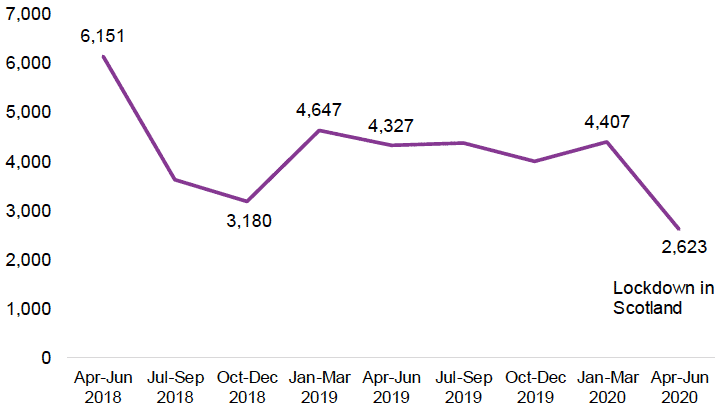
Of the total number of people referred to FSS, 24,380 people went on to receive employability support services. FSS set out to support 38,000 people in the first three years. FSS has achieved 64% of this figure, with 9 months left of year 3 to report on. The proportion of referrals starting FSS support has increased over time. On average, in the first year, 59% of referrals joined FSS, rising to 70% in the second year, and at least 82% in the first quarter of year 3 (the latest quarter).
As Figure 2 shows the start rate in the latest quarter is higher than any previous quarter, and may still increase as not everyone referred over the quarter has had enough time to decide whether or not to join FSS. The changes in referral sources (described in the introduction section) were highlighted as a possible reason for the increase in start rate over the last quarter.
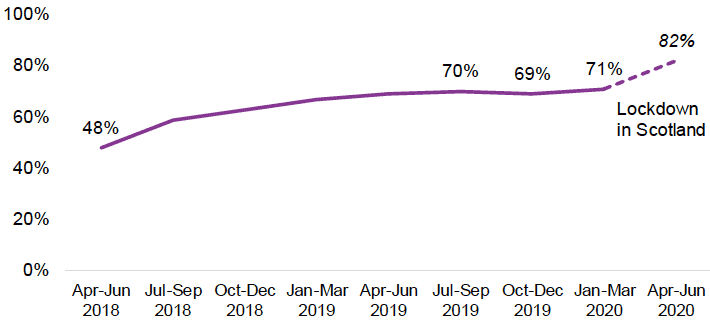
Note:
1. The April - June 2020 start rate is not complete yet and may rise further.
The Scottish Government's evaluation of the first year of the service[4] highlighted that compared to the unemployed population of Scotland there are some groups under-represented in FSS: women, people from a minority ethnic background and young people. Since the first year of FSS, there have been changes in the demographic composition of those joining the service, the latest data (Figure 3) shows that overall:
- 36% of people joining FSS are women and 64% are men. The proportion of women has increased over time: from 35% in year 1, to 37% in year 2, and now 40% in the first quarter of year 3.
- the most common age group for people joining FSS was 35-49 years (28% of people), followed by 50 years old and over (26%), 25-34 years old (23%), and 16 to 24 years old (19%). The proportion of people joining FSS in the younger age groups (16 to 34) has increased, from 38% in year 1, to 44% in year 2, and is now at 56% in the most recent quarter. There has been a corresponding fall for the older age groups (35 and over), from 60% in year 1, to 52% in year 2, to 43% in the most recent quarter.
- 69% of people joining FSS are white, with 5% of people joining from minority ethnic backgrounds. Ethnicity data is not available for the remaining 26%. A comparison over time is not presented due to an increase in missing information on ethnicity in year 2 and the latest quarter.[5]
- 47% of people joining FSS reported a disability. The proportion reporting a disability decreased from 55% in year 1 to 44% in year 2, and is only 27% in the most recent quarter. There has been a corresponding increase in people who are not disabled, from 37% in year 1, to 47% in year 2, to 64% in the most recent quarter.
- 65% of people joining FSS reported having a long-term health condition, and 28% reported no long-term health condition, with the rest unknown.
- Figure 4 shows that the most common health condition reported was mental health (34%). Between year 1 and 2 there was a 5 percentage point increase in people reporting a mental health condition among those joining FSS, from 31% to 36%; with the most recent quarter remaining at 36%.
- The second most common health condition category reported was long-term illness, disease or condition, which affects 17% of people joining FSS and has not changed much over time.
- Physical disabilities were the third most common long-term health condition category reported. The number of people reporting a physical disability has declined over time: from 14% in year 1, to 10% in year 2, to 5% in the most recent quarter.
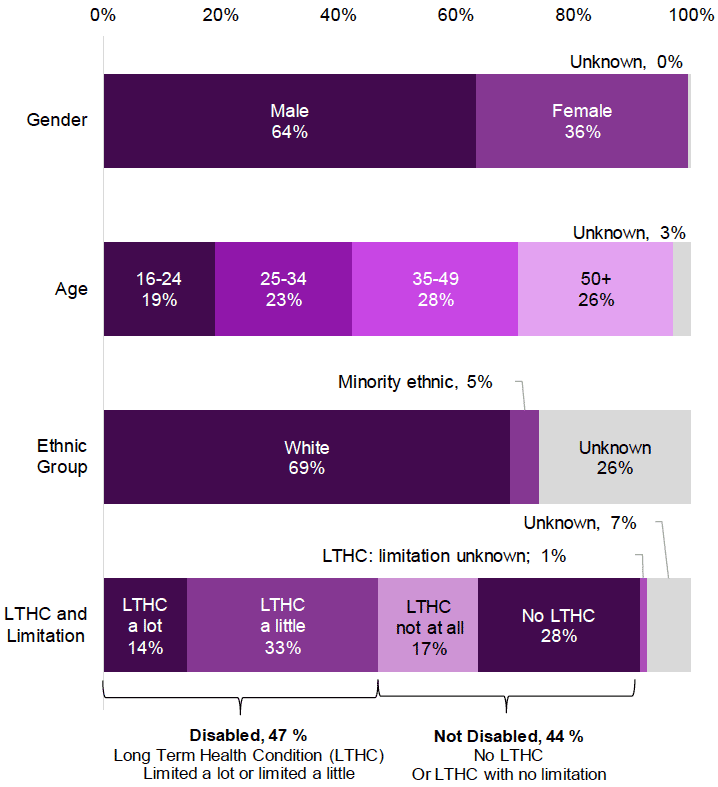
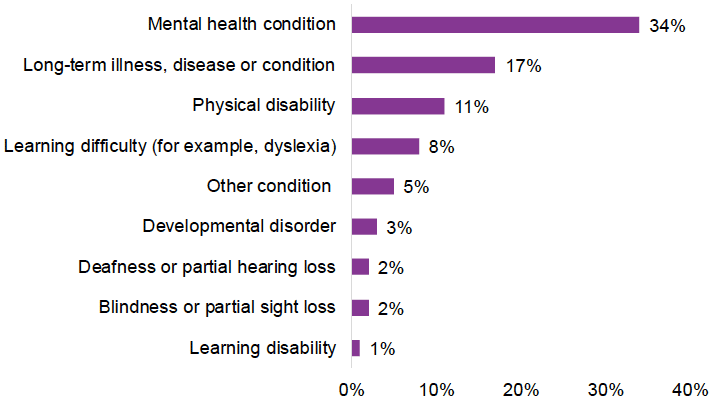
How many people left FSS early?
Someone is defined as having left FSS early (an 'early leaver') if they leave FSS before the end of the pre-employment support period and without having sustained employment for at least 3 months. The pre-employment support period usually lasts for up to 1 year. In some cases, it can last up to 18 months, but this has only applied to a small number of people so far.
Overall, 8,472 people have left FSS early. As with job outcomes, as time goes on we get a more complete picture of numbers staying on FSS or leaving early. Where we have a complete picture,[6] 51% of people starting left the service early.
In the latest quarter the number of people leaving early was far lower than in previous quarters. In April - June 2019, 15% of those who started over the previous 12 months left FSS early. This proportion decreased to 3% in the latest quarter (April - June 2020). This decrease needs to be considered in relation to the changing context in the labour market and the delivery of FSS due to COVID-19.
Figure 5 shows that the percentage leaving early is broadly similar for most of the equalities groups. However, the percentage is higher for those reporting a disability, particularly for those who have a long-term health condition that limits daily activities a lot (57% left early). The proportion of people leaving early was lower for those who had a long-term health condition that did not limit daily activities at all (45%).
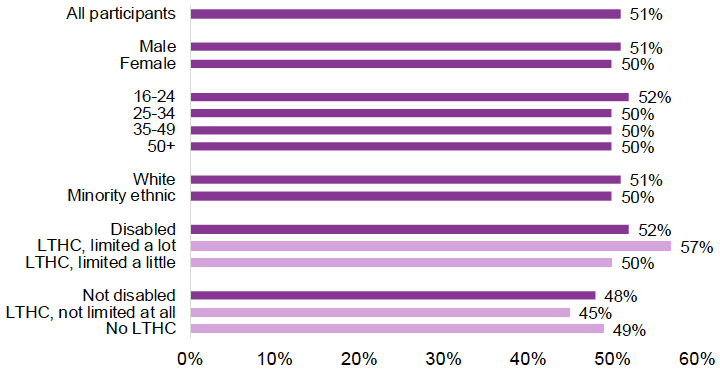
How many people entered and sustained employment?
A total of 7,050 people joining have started a job. On average, most people who started a job found employment within three months of joining FSS.
COVID-19 has had an impact on the labour market, and the number of job vacancies[9] available. Figure 6 has been included to show changes in FSS job starts since the COVID-19 lockdown period began in March 2020. It shows that FSS job starts in April - June 2020 were 20% lower than the same period in 2019.
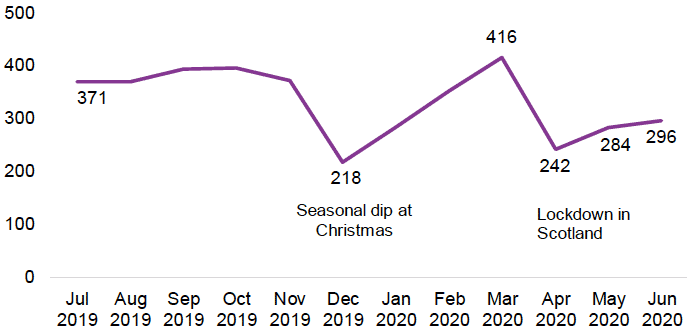
Of the 7,050 people who started work, 4,193 of those had sustained employment for at least 3 months (13 weeks), 2,753 were employed for at least 6 months (26 weeks) and 1,238 were employed for at least 12 months (52 weeks).
Job outcome rates can only be reported for start cohorts where enough time has passed in pre employment support and for outcomes to be achieved. These show:
- most people who started FSS did not enter work or go on to sustain employment: 33% started a job, 23% sustained employment for 3 months, 17% sustained employment for 6 months, and 14% sustained employment for 12 months.
- however, many people who started jobs went on to sustain them: 72% of people starting jobs went on to sustain employment for 3 months, 77% of the people who sustained employment for 3 months went on to reach 6 months, and 76% of those who sustained employment for 6 months went on to reach at least 12 months.
Figures 7, 8, 9 and 10 show how the rates of job starts and outcomes compare between different equality groups.
The rates of job starts and outcomes do not show a large difference by gender, and are never more than 1 percentage point different. More men (33%) than women (32%) start a job. The opposite is true when looking at 3 month (men: 23%, women: 24%), 6 month (men: 17%, women: 18%), and 12 month (men: 13%, women: 14%) job outcomes.
The biggest differences are seen with age and with long-term health conditions, which are often related. 40% of 16-24 year olds started work after joining FSS, whereas a lower proportion (28%) of those aged 50 and above started work - a difference of 12 percentage points. The difference between these two groups narrows when considering duration of employment at 3 month (9 percentage points), 6 month (5 percentage points) and 12 month (1 percentage point) sustained jobs outcomes
22% of those with a long-term health condition that limited daily activities a lot went on to start work, whereas a higher proportion (38%) of those with a health condition that did not limit daily activities went on to start work. This is a difference of 16 percentage points. The difference between these two groups narrows when considering duration of employment at 3 month (12 percentage points) 6 month (9 percentage points) and 12 month (6 percentage points) sustained outcomes.
33% of white participants went on to start work, whereas a higher proportion of minority ethnic participants (38%) went on to start work. This is a gap of 5 percentage points, which remains similar for 3 month (3 percentage points) and 6 month (5 percentage points) job outcomes, but is much higher at 12 months (11 percentage points).
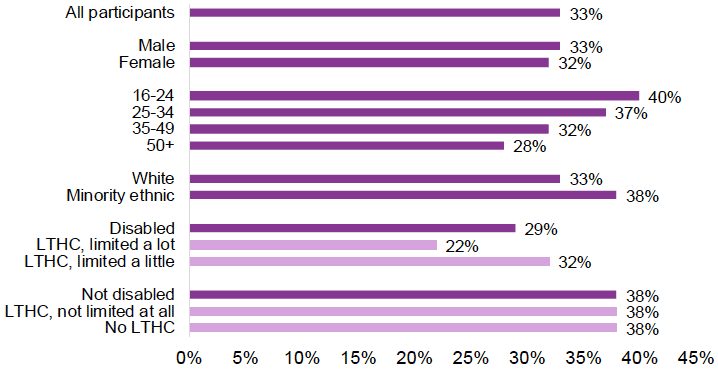
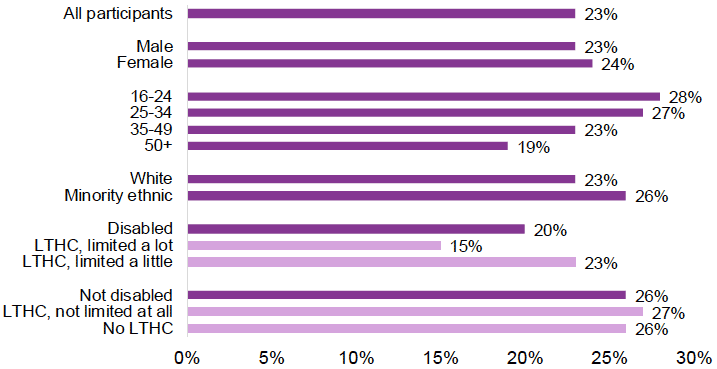
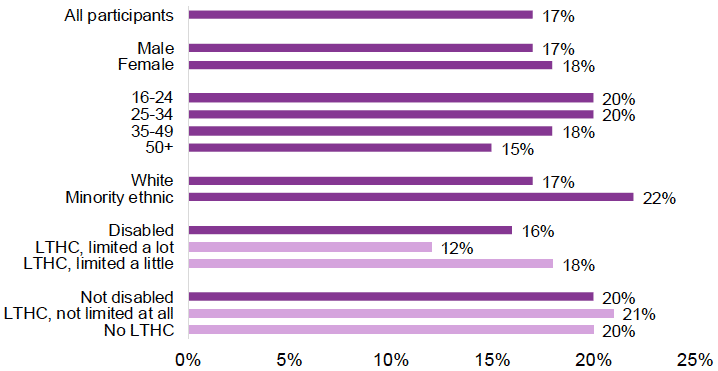
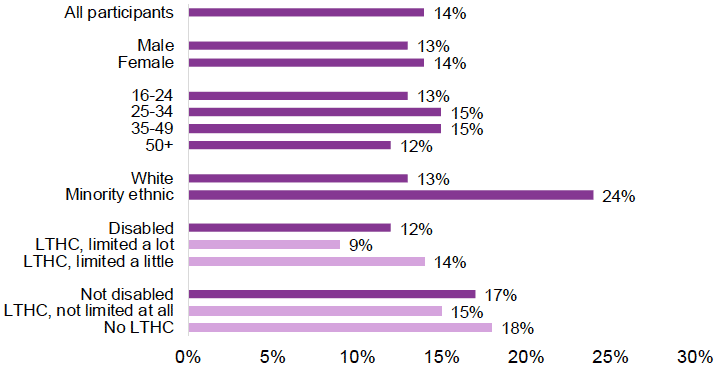
Contact
Email: employabilitydata@gov.scot
There is a problem
Thanks for your feedback